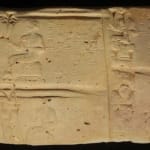Sumerian Cuneiform Tablet, 2025 BCE
1.85 x 2.95
AM.0054
Sumerian cuneiform is one of the earliest known forms of written expression. First appearing in the 4th millennium BC in what is now Iraq, it was dubbed cuneiform (‘wedge-shaped’) because...
Sumerian cuneiform is one of the earliest known forms of written expression. First appearing in the 4th millennium BC in what is now Iraq, it was dubbed cuneiform (‘wedge-shaped’) because of the distinctive wedge form of the letters, created by pressing a reed stylus into wet clay. Early Sumerian writings were essentially pictograms, which became simplified in the early and mid 3rd millennium BC to a series of strokes, along with a commensurate reduction in the number of discrete signs used (from c.1500 to 600). The script system had a very long life and was used by the Sumerians as well as numerous later groups – notably the Assyrians, Elamites, Akkadians and Hittites – for around three thousand years. Certain signs and phonetic standards live on in modern languages of the Middle and Far East, but the writing system is essentially extinct. It was therefore cause for great excitement when the ‘code’ of ancient cuneiform was cracked by a group of English, French and German Assyriologists and philologists in the mid 19th century AD. This opened up a vital source of information about these ancient groups that could not have been obtained in any other way.
Cuneiform was used on monuments dedicated to heroic – and usually royal – individuals, but perhaps its most important function was that of record keeping. The palace-based society at Ur and other large urban centres was accompanied by a remarkably complex and multifaceted bureaucracy, which was run by professional administrators and a priestly class, all of whom were answerable to central court control. Most of what we know about the way the culture was run and administered comes from cuneiform tablets, which record the everyday running of the temple and palace complexes in minute detail, as in the present case. The Barakat Gallery has secured the services of Professor Lambert (University of Birmingham), a renowned expert in the decipherment and translation of cuneiform, to examine and process the information on these tablets. His scanned analysis is presented here. This document is a record of the handing over of a quantity of barley to a city governor.
Professor Lambert’s translation is provided below:
Clay tablet, 75x47mm., with 13 lines of Sumerian cuneiform on obverse and reverse, the tablet rolled with scribe’s cylinder seal. An administrative document from the period of the Third Dynasty of Ur, dated to the th year of Ibbi-Sin, last king of the dynasty c. 2025 B.C. It is a record of the handing over of a quantity of barley to a city governor:
Translatio
49 gur of barley: its area 30 iku, barley rations for Lu-Zikum and Mahasabarr
Foreman: Anid
Field: Imlik-Shi-Si
Barley of Enna-bahumuda . . . . . . .
Anida took an oath in the king’s name
Ur-Mes, the city governor took (the barley)
Year: En’amgal-anna, high priestess of Inanna was enthroned
The cylinder seal had an inscription in two columns, most of which can be read:
Ibbi-Sin, mighty King, king of Ur, king of the four quarters,
to Anida his servant he gave this sea
The seal design shows a standing human in front of a seated god, on a padded stool. The human was meant as the seal owner, so here Anida.
A gur was a measure of capacity, made up of 300 sila, and a sila was about 85 of a litre.
Cuneiform was used on monuments dedicated to heroic – and usually royal – individuals, but perhaps its most important function was that of record keeping. The palace-based society at Ur and other large urban centres was accompanied by a remarkably complex and multifaceted bureaucracy, which was run by professional administrators and a priestly class, all of whom were answerable to central court control. Most of what we know about the way the culture was run and administered comes from cuneiform tablets, which record the everyday running of the temple and palace complexes in minute detail, as in the present case. The Barakat Gallery has secured the services of Professor Lambert (University of Birmingham), a renowned expert in the decipherment and translation of cuneiform, to examine and process the information on these tablets. His scanned analysis is presented here. This document is a record of the handing over of a quantity of barley to a city governor.
Professor Lambert’s translation is provided below:
Clay tablet, 75x47mm., with 13 lines of Sumerian cuneiform on obverse and reverse, the tablet rolled with scribe’s cylinder seal. An administrative document from the period of the Third Dynasty of Ur, dated to the th year of Ibbi-Sin, last king of the dynasty c. 2025 B.C. It is a record of the handing over of a quantity of barley to a city governor:
Translatio
49 gur of barley: its area 30 iku, barley rations for Lu-Zikum and Mahasabarr
Foreman: Anid
Field: Imlik-Shi-Si
Barley of Enna-bahumuda . . . . . . .
Anida took an oath in the king’s name
Ur-Mes, the city governor took (the barley)
Year: En’amgal-anna, high priestess of Inanna was enthroned
The cylinder seal had an inscription in two columns, most of which can be read:
Ibbi-Sin, mighty King, king of Ur, king of the four quarters,
to Anida his servant he gave this sea
The seal design shows a standing human in front of a seated god, on a padded stool. The human was meant as the seal owner, so here Anida.
A gur was a measure of capacity, made up of 300 sila, and a sila was about 85 of a litre.



